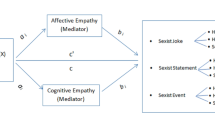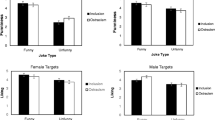Abstract
The current study tested Freud's (1905/1960)theory that sexist humor may be associated withhostility toward women and extended previous researchshowing a link between hostile humor and aggression.Colleges students (N = 399 — approximately 92%white, 5% African American, and 3% other minorities)rated 10 sexist jokes on their perceived funniness.Results showed that the enjoyment of sexist humor waspositively correlated with rape-related attitudes andbeliefs, the self-reported likelihood of forcing sex,and psychological, physical, and sexual aggression inmen. For women, the enjoyment of sexist humor was only positively correlated with Adversarial SexualBeliefs and Acceptance of Interpersonal Violence. Womenalso found the jokes to be less enjoyable, lessacceptable, and more offensive than the men, but they were not significantly less likely to tell thejokes.
Similar content being viewed by others
REFERENCES
Berkowitz, L. (1970a). Aggressive humor as a stimulus to aggressive responses. Journal of Personality and Social Psychology, 16, 710-717.
Berkowitz, L. (1970b). Experimental investigations of hostility catharsis. Journal of Consulting and Clinical Psychology, 35, 1-7.
Berkowitz, L. (1993). Aggression: Its causes, consequences, and control. New York: McGraw-Hill.
Bill, B., & Naus, P. (1992). The role of humor in the interpretation of sexist incidents. Sex Roles, 27, 645-664.
Bookwala, J., Frieze, I. H., Smith, C., & Ryan, K. (1992). Predictors of dating violence: A multivariate analysis. Violence and Victims, 7, 297-311.
Burt, M. R. (1980). Cultural myths and support for rape. Journal of Personality and Social Psychology, 38(2),217-230.
Byers, E. S., & Eno, R. J. (1991). Predicting men's sexual coercion and aggression from attitudes, dating history, and sexual response. Journal of Psychology and Human Sexuality, 4, 55-70.
Byrne, D. (1961). Some inconsistencies in the effect of motivation arousal on humor preferences. Journal of Abnormal and Social Psychology, 62, 158-160.
Cantor, J. R. (1976). What is funny to whom? The role of gender. Journal of Communication, 26, 164-172.
Chapman, A. J., & Gadfield, N. J. (1976). Is sexual humor sexist? Journal of Communication, 26, 141-153.
Check, J. V. P., Malamuth, N. M., Elias, B., & Barton, S. (1985, April). On hostile ground. Psychology Today, 56-61.
Christopher, F. S., Owens, L. A., & Stecker, H. L. (1993). Exploring the darkside of courtship: A test of a model of male premarital sexual aggressiveness. Journal of Marriage and the Family, 55, 469-479
Coser, R. L. (1960). Laughter among colleagues. Psychiatry, 23, 81-95.
Dworkin, E. S., & Efran, J. S. (1967). The angered: Their susceptibility to varieties of humor. Journal of Personality and Social Psychology, 6, 233-236.
Epstein, S., & Smith, R. (1969). Repression and insight as related to reaction to cartoons. In J. Levine (Ed.), Motivation in humor. New York: Atherton Press.
Fine, G. A. (1976). Obscene joking across cultures. Journal of Communication, 26, 134-140.
Freud, S. (1905/1960). Jokes and their relation to the unconscious. New York: Norton.
Hertzler, J. O. (1970). Laughter: A socio-scientific analysis. New York: Exposition Press.
Johnson, A. M. (1991). Sex differences in the jokes college students tell. Psychological Reports, 68, 851-854.
Koss, M. P., & Dinero, T. E. (1988). Predictors of sexual aggression among a national sample of male college students. Annals of New York Academy of Science, 528, 133-147.
Koss, M. P., Leonard, K. E., Beezley, D. A., & Oros, C. J. (1985). Nonstranger sexual aggression: A discriminant analysis of the psychological characteristics of undetected offenders. Sex Roles, 12, 981-992.
Landy, D., & Mettee, D. (1969). Evaluation of an aggressor as a function of exposure to cartoon humor. Journal of Personality and Social Psychology, 12, 66-71.
Lisak, D., & Roth, S. (1990). Motives and psychodynamics of self-reported, unincarcerated rapists. American Journal of Orthopsychiatry, 60, 268-280.
Lonsway, K. A., & Fitzgerald, L. F. (1995). Attitudinal antecedents of rape myth acceptance: A theoretical and empirical reexamination. Journal of Personality and Social Psychology, 68, 704-711.
Losco, J., & Epstein, S. (1975). Humor preference as a subtle measure of attitudes toward the same and the opposite sex. Journal of Personality, 43, 321-334.
Love, A. M., & Deckers, L. H. (1989). Humor appreciation as a function of sexual aggression and sexual content. Sex Roles, 20, 649-654.
Lyman, P. (1987). The fraternal bond as a joking relationship: A case study of the role of sexist jokes in male group bonding. In M. S. Kimmel (Ed.), Changing men: New directions in research on men and masculinity. Newbury Park, CA: Sage.
Malamuth, N. M. (1988). A multidimensional approach to sexual aggression: Combining measures of past behavior and present likelihood. Annals of New York Academy of Science, 528, 123-132.
Malamuth, N. M. (1989). The attraction to sexual aggression scale: Part one. The Journal of Sex Research, 26, 26-49.
Malamuth, N. M., Sockloskie, R. J., Koss, M. P., & Tanaka, J. S. (1991). Characteristics of aggressors against women: Testing a model using a national sample of college students. Journal of Consulting and Clinical Psychology, 59, 670-681.
Moore, T. E., Griffith, K., & Payne, B. (1987). Gender, attitudes towards women, and the appreciation of sexist humor. Sex Roles, 16, 521-531.
Muehlenhard, C., & Linton, M. (1987). Date rape and sexual aggression in dating situations: Incidence and risk factors. Journal of Counseling Psychology, 34, 186-196.
Neuliep, J. W. (1987). Gender differences in the perception of sexist and nonsexist humor. Journal of Social Behavior and Personality, 2, 345-351.
Pryor, J. B. (1995a). The phenomenology of sexual harassment: Why does sexual behavior bother people in the workplace? Consulting Psychology Journal: Practice and Research, 47, 160-168.
Pryor, J. B. (1995b). The psychosocial impact of sexual harassment on women in the U.S. military. Basic and Applied Social Psychology, 17, 581-603.
Pryor, J. B., Giedd, J. L., & Williams, K. B. (1995). A social psychological model for predicting sexual harassment. Journal of Social Issues, 51, 69-84.
Richlin, A. (1992). The garden of Priapus: Sexuality and aggression in Roman humor (rev. ed.). New York: Oxford University Press.
Ryan, K. M. (in press). The relationship between courtship violence and sexual aggression in college students. Journal of Family Violence.
Sigelman, C. K., Berry, C. J., & Wiles, K. A. (1984). Violence in college students' dating relationships. Journal of Applied Social Psychology, 5, 530-548.
Singer, D. L. (1968). Aggression arousal, hostile humor, catharsis. Journal of Personality and Social Psychology Monograph Supplement, 8, 1-14.
Stets, J. E., & Pirog-Good, M. A. (1989). Patterns of physical and sexual abuse for men and women in dating relationships: A descriptive analysis. Journal of Family Violence, 4, 63-76.
Straus, M. A., Hamby, S. L., Boney-McCoy, S., & Sugarman, D. B. (1995). The Revised Conflict Tactics Scale (CTS2). Durham, NH: Family Research Laboratory, University of New Hampshire.
Strickland, J. F. (1959). The effect of motivation arousal on humor preferences. Journal of Abnormal and Social Psychology, 59, 278-281.
Weisz, M. G., & Earls, C. M. (1995). The effects of exposure to filmed sexual violence on attitudes toward rape. Journal of Interpersonal Violence, 10, 71-84.
White, J., & Kowalski, R. M. (1994). Deconstructing the myth of the nonaggressive woman: A feminist analysis. Psychology of Women Quarterly, 18, 487-508.
Young, R. D., & Frye, M. (1966). Some are laughing; Some are not—why? Psychological Reports, 18, 747-754.
Ziv, A., & Gadish, O. (1990). The disinhibiting effects of humor: Aggressive and affective responses. Humor, 3, 247-257.
Rights and permissions
About this article
Cite this article
Ryan, K.M., Kanjorski, J. The Enjoyment of Sexist Humor, Rape Attitudes, and Relationship Aggression in College Students. Sex Roles 38, 743–756 (1998). https://doi.org/10.1023/A:1018868913615
Issue Date:
DOI: https://doi.org/10.1023/A:1018868913615




